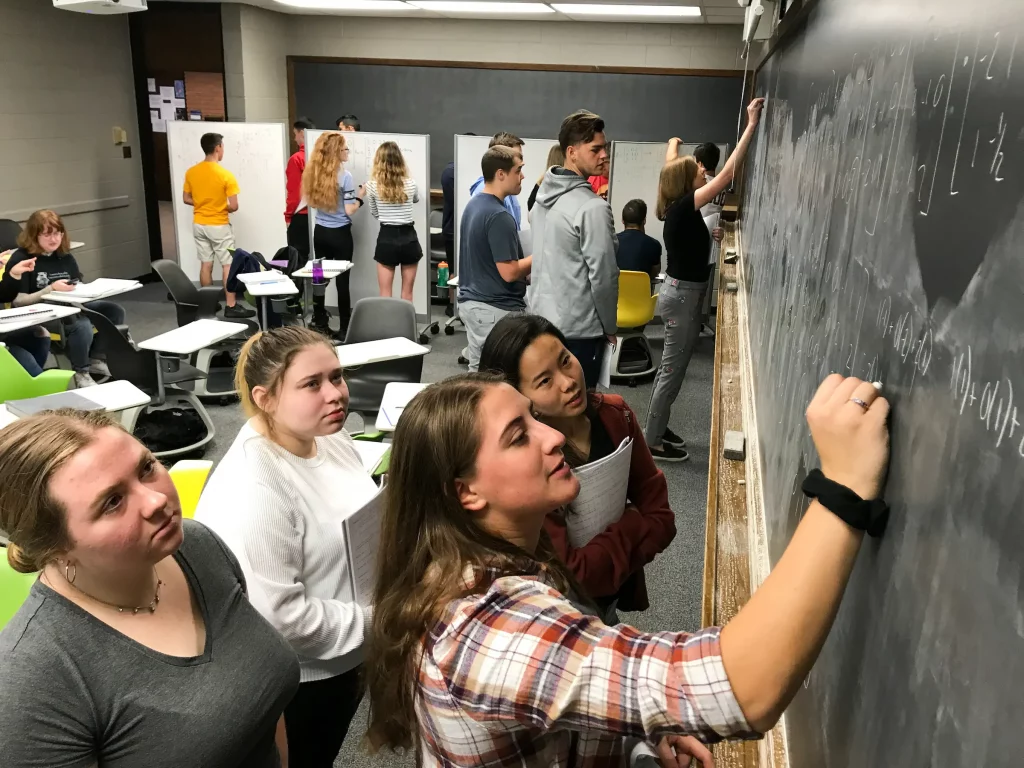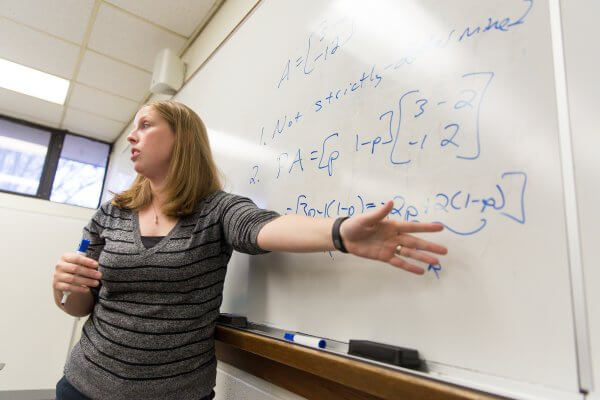Major in Statistics

Why Statistics at Valpo?
Statistics isn’t just about the numbers. After graduation, our statistics alumni go in every direction, from public health and education to manufacturing and finance. Statisticians are the ones who study the safety of nuclear power plants, evaluate the environmental impact of pollution, determine the effectiveness of new medicines, and analyze consumer demand for products – an integral part of society at large.
According to the United States Bureau of Labor Statistics, employment opportunities in statistics are projected to grow 30% through 2032. At Valpo, students are given hands-on foundations in statistical theory and real-life applications through analysis, theory, and research – meeting industry demand with an edge.
Note: This program is no longer enrolling new students. Please view our other available mathematics degree options.
Statistics Highlights
Real-Life Research and Analysis
Students are equipped with a broad range of statistics and mathematics courses focused on real-world applications, encouraging the growth of quantitative problem-solving and communication skills.
Two Degree Pathways
Completion of the degree requirements of the College of Arts and Sciences with a major in statistics leads to a bachelor of arts or a bachelor of science degree. The difference: A bachelor of arts places greater emphasis on the humanities, while a bachelor of science focuses more on natural sciences and analysis.
Involvement Outside the Classroom
Students have every opportunity to turn their coursework into reality at events like the Mathematics Colloquium and the Statistics and Data Science Colloquium. They can also get involved on campus with math club and Pi Mu Epsilon, the national mathematics honor society.
Statistics Major Requirements
The College of Arts and Sciences offers students interested in statistics two structurally similar degrees with 124-credit programs depending on their general education pathway: a bachelor of arts in statistics, and a bachelor of science in statistics.
When deciding between a bachelor of arts or a bachelor of science in statistics, please note that the core classes required for the B.A. pathway place a greater emphasis on the humanities; the core classes required for the B.S. pathway places a greater emphasis on natural sciences and analysis, requiring an additional quantitative analysis credit, and a complementary minor or a second major in the sciences.
- Students majoring in statistics may not pursue a minor in applied statistics.
- Students majoring in statistics who are also pursuing either a degree in mathematics or a complementary degree in mathematics may not use courses with a STAT prefix to fulfill any of the upper-level elective requirements for either major.
| Major Requirements for Statistics | ||
|---|---|---|
| Introductory Statistics Course One course from the following options: Note: The preferred statistics course is STAT 240. |
||
| STAT 140 | General Statistics | 3 credits |
| STAT 240 | Statistical Analysis | 3 credits |
| PSY 201 | Statistical Methods | 3 credits |
| BUS 205 | Business Statistics | 3 credits |
| CE 202 | Statistical Applications in Civil, Engineering | 3 credits |
| Intermediate Statistics Course One Course From the Following Options: |
||
| STAT 340 | Statistics for Decision Making | 3 credits |
| BAN 340 | Statistics for Decision Making | 3 credits |
| ECON 325 | Econometrics | 3 credits |
| Core | ||
| DATA 151 | Introduction to Data Science | 3 Credits |
| STAT 299 | Statistics Colloquium I | 1 Credit |
| STAT 343 | Time Series Analysis | 3 Credits |
| STAT 344 | Stochastic Processes | 3 Credits |
| STAT 361 | Introduction to R | 1 Credit |
| STAT 363 | Introduction to SAS | 3 Credits |
| STAT 399 | Statistics Colloquium II | 1 Credit |
| STAT 441 | Probability | 4 Credits |
| STAT 442 | Mathematical Statistics | 3 Credits |
| STAT 499 | Statistics Colloquium III | 1 Credit |
| Elective One Course From the Following Options: Note: The chosen elective cannot be used to fulfill requirements of any other major or minor. |
||
| ACRS 325 | Actuarial Modeling | 3 Credits |
| BIO 321 | Math Models of Infectious Disease | 3 Credits |
| OR | ||
| MATH 321 | Mathematical Models of Infectious Diseases | 3 Credits |
| BAN 440 | Machine Learning | 3 Credits |
| CS 325 | Simulation and Modeling | 3 Credits |
| DATA 433 | Data Mining and Applications | 3 Credits |
| ECON 473 | Applied Data Science | 3 Credits |
| GEO 460 | Data Analysis | 3 Credits |
| OR | ||
| MET 460 | Data Analysis | 3 Credits |
| POLS 210 | Research Methods in Political Science | 3 Credits |
| PSY 202 | Research Methods in Psychology | 3 Credits |
| SOC 320 | Research Methods II: Data Analysis | 3 Credits |
| STAT 490 | Advanced Topics in Statistics | 3 Credits |
| Additional Required Courses | ||
| MATH 132 | Calculus II | 4 Credits |
| MATH 253 | Calculus III | 4 Credits |
| One Course From the Following Options: | ||
| MATH 126 | Calculus and Functions Part II | 4 Credits |
| MATH 131 | Calculus I | 4 Credits |
| One Course From the Following Options: | ||
| MATH 260 | Linear Systems and Matrices | 1 Credit |
| MATH 264 | Linear Algebra | 3 Credits |
| Minor Requirements (Minimum 15 Cr.) | ||
|---|---|---|
| One course from the following: |
||
| STAT 140 | General Statistics | 3 credits |
| STAT 240 | Statistical Analysis | 3 credits |
| PSY 201 | Statistical Methods | 3 credits |
| BUS 205 | Business Statistics | 3 credits |
| CE 202 | Statistical Applications in Civil, Engineering | 3 credits |
| One course from the following: | ||
| STAT 340 | Statistics for Decision Making | 3 credits |
| BAN 340 | Statistics for Decision Making | 3 credits |
| ECON 325 | Econometrics | 3 credits |
| At least 9 credits from the following: |
||
| BIO 321 | Math Models of Infectious Disease | 3 Credits |
| OR | ||
| MATH 321 | Mathematical Models of Infectious Diseases | 3 Credits |
| BAN 440 | Machine Learning | 3 Credits |
| CS 325 | Simulation and Modeling | 3 Credits |
| DATA 433 | Data Mining and Applications | 3 Credits |
| ECON 473 | Applied Data Science | 3 Credits |
| GEO 460 | Data Analysis | 3 Credits |
| OR | ||
| MET 460 | Data Analysis | 3 Credits |
| POLS 210 | Research Methods in Political Science | 3 Credits |
| PSY 202 | Research Methods in Psychology | 3 Credits |
| SOC 320 | Research Methods II: Data Analysis | 3 Credits |
| STAT 299 | Statistics Colloquium I | 1 Credit |
| STAT 343 | Time Series Analysis | 3 Credits |
| STAT 344 | Stochastic Processes | 3 Credits |
| STAT 361 | Introduction to R | 1 Credit |
| STAT 362 | Introduction to Python | 1 Credit |
| STAT 363 | Introduction to SAS | 3 Credits |
| STAT 399 | Statistics Colloquium II | 1 Credit |
| STAT 441 | Probability | 4 Credits |
| STAT 442 | Mathematical Statistics | 3 Credits |
| STAT 490 | Advanced Topics in Statistics | 3 Credits |
| STAT 499 | Statistics Colloquium III | 1 Credit |
Statistics Career Outcomes
Ranked as one of the top 15 overall jobs by the U.S. News & World Report, the need for skilled statisticians can only go up. Even beyond statisticians, degrees in data science, statistics, or math foster robust problem-solving and analytical skills which increase a candidate’s appeal across professional fields. Our alumni have gone on to work for AmeriCorps VISTA, Caterpillar, Epic Systems, Motorola, and the U.S. States Department of Defense.
Some sought-after careers in statistics include:
- Consumer analyst
- Environmental statistician
- Government employee
- Teacher

THE STATISTICS AND DATA SCIENCE COLLOQUIUM

